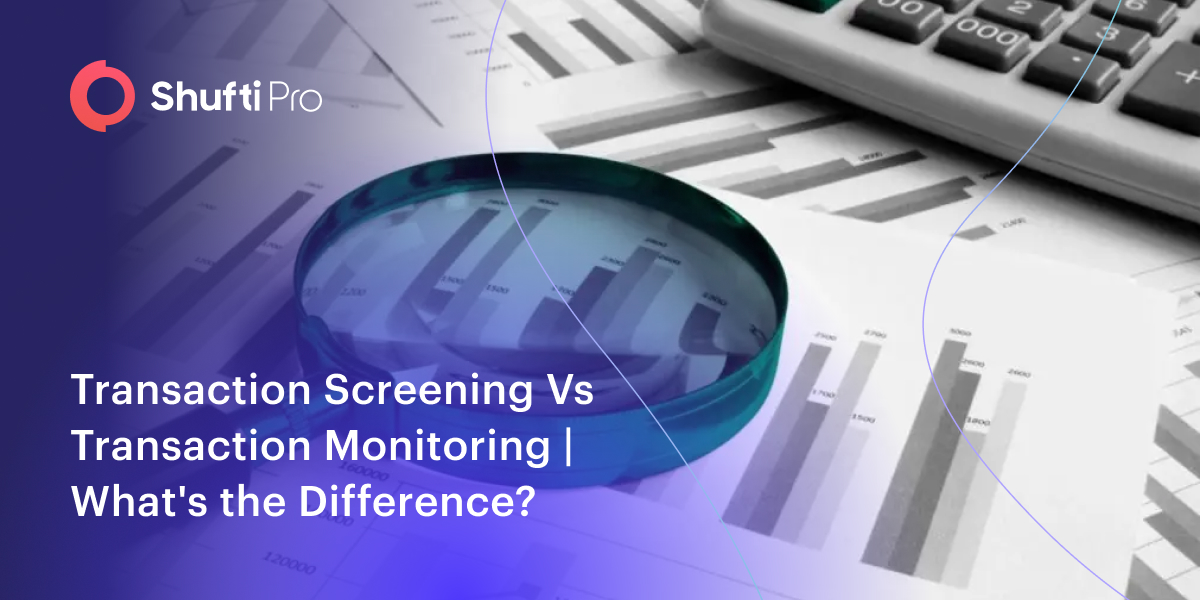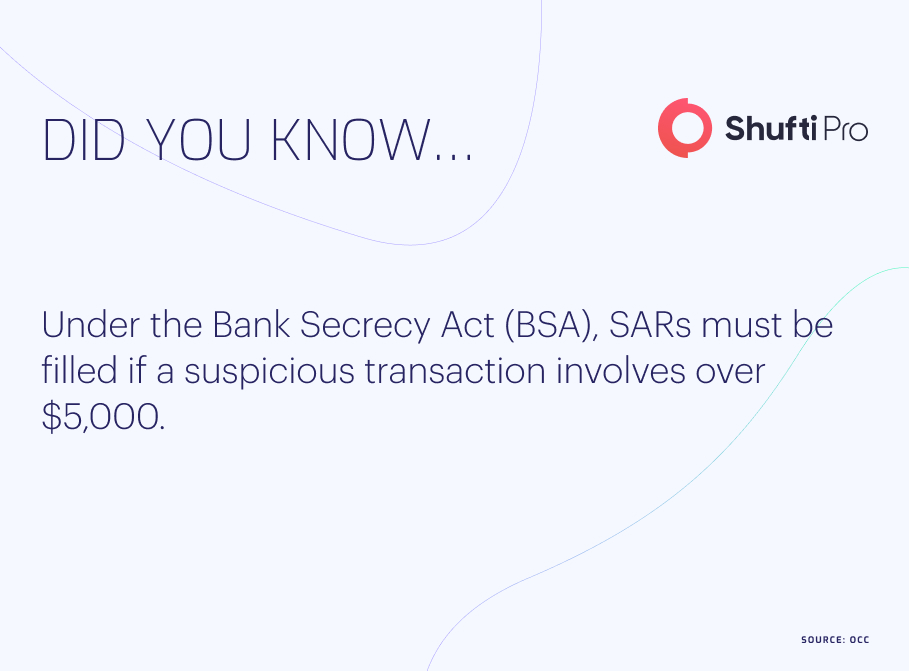Transaction Screening Vs Transaction Monitoring | What’s the Difference?

- 01 What is Transaction Screening?
- 02 What is Transaction Monitoring?
- 03 Transaction Screening Vs Transaction Monitoring
- 04 The Importance of Transaction Screening and Monitoring
- 05 Regulations | Transaction Screening and Monitoring
- 06 An Efficient Transaction Monitoring and Transaction Screening Solution
- 07 Mitigate Risks With Shufti
Transaction screening and transaction monitoring are critical in money laundering, counter-terrorism financing (AML/CFT), and fraud prevention. Screening and monitoring are two independent yet interconnected concepts. Nevertheless, screening refers to identifying risk before proceeding with the transaction, whereas monitoring is an after-process that involves keeping a watchful and alert eye on the transaction and account.
Since the digitisation and advancement of complex cyber and financial crimes, the global fraud rate has risen from 13% in 2021 to 16% in 2022, making transaction monitoring a must-have for all banks, financial enterprises, and organisations. If done traditionally, it could be a daunting task that requires a substantial amount of time and effort. Transaction screening is essential for maintaining sufficient attentiveness and completing compliance processes. However, the question of how it is done, which procedure is employed at one time, and if it is required or not emerges. Learn the difference between transaction screening and monitoring, as well as their benefits, roles, and significance.
What is Transaction Screening?
Customer Due Diligence (CDD) is a component of a firm’s CFT and fraud risk control that includes transaction screening. It is an important part of a company’s compliance with laws and regulations. Payment screening is tasked explicitly with detecting danger in transactions before they have been accepted and completed. Transaction screening, in general, examines the information related to a transaction to make sure it does not raise suspicious activity for financial crime. It aids in the surveillance of terrorist financing, corruption, illicit financial crime, money laundering, fraud, theft, sanction evasion, and weapon proliferation.
Organisational and third-party risk data should be included in effective transaction screening solutions. The procedure should be capable of identifying critical red flags for potential risks identified in a firm’s Enterprise-Wide Risk Assessment (EWRA), as well as being in compliance with regulatory standards. It must be able to integrate with the company’s whole risk data set, including compliance and theft. Finally, it should clearly communicate this data to analysts, allowing them to analyse warnings and examine, escalate, and stop suspicious activity.
Effective Transaction Screening Process
A successful transaction screening programme must include several components:
- Before a transaction can be approved or proceeded with, it must be screened.
- It detects authorised entities, regions, and activities to achieve successful results.
- The screening is based on sanctions lists that are updated as soon as regulators do.
- The screening must be thoroughly incorporated into a firm’s overall risk data.
- It gives analysts with clear risk information, allowing for effective remediation.
- Corporate and third-party risk insights are included in the efficient screening process.
What is Transaction Monitoring?
The continual practice of monitoring transactions for threats after they are finished and processed is known as transaction monitoring. Inbound and outbound transactions are monitored for fraud indicators, money laundering, terrorist financing, sanctions violations, and other criminal behaviors in keeping with a firm’s risk profile.
It is critical to effective transaction monitoring to have an accurate and transparent data collection. An exceptional transaction monitoring technology enables businesses to consider all transaction warnings in the context of other risk data. When experts can see warnings in the context of the firm’s wider risk data, they can rectify them more efficiently.
Effective Transaction Screening Process
An effective transaction monitoring solution involves several procedures, a few of which are as follows:
- Examining previously completed transactions, ideally in real-time.
- Detecting financial crime risks through the use of rules, artificial intelligence, or a mix of the two.
- Access to additional risk data, such as transaction screening and previous investigations.
- Giving analysts clear information and context.
Transaction Screening Vs Transaction Monitoring
Transaction screening examines specific transactions, such as payments, before they are accepted to prevent particularly high-risk activities. A transaction to a prohibited business or for illegal items, for example, can be refused regardless of the customer’s previous conduct.
Suspicious Transaction monitoring, on the contrary, analyses the transaction patterns for suspicious activity after they have been approved. Some transactions may appear to be a low risk on their own and hence pass the screening procedure. However, if they are part of a larger network of questionable behavior, their connection to previous transactions can prompt monitoring teams to continue investigating.
The Importance of Transaction Screening and Monitoring
Transaction screening and monitoring, when combined, can help businesses find hidden threats and stop or report illegal activities whilst safeguarding customers from fraud. This can assist businesses in staying ahead of developing criminal threats, fraud, and regulatory requirements. To accomplish this, transaction screening and monitoring must be integrated into trustworthy, up-to-date, and comprehensive data sets. The correct technologies can be learned from previous investigations and adapted to the real-world setting of a firm’s risk management.

Businesses can meet and even surpass regulatory standards by screening and monitoring transactions in a risk-based approach. Effective transaction screening and monitoring can also enhance the client’s experience and increase customer loyalty. For AML/CFT and fraud prevention to be effective, transaction monitoring and screening need to be accompanied by effective tools. The efficient monitoring and screening system may free up resources, assist businesses in meeting regulatory requirements, and improve corporate performance.
Regulations | Transaction Screening and Monitoring
Rather than predetermining specific tools and methods for AML/CFT, regulators often adopt a risk-based approach. Nonetheless, transaction screening and monitoring are essential components of a successful programme. Regulators need organisations to have accurate and reliable client information as well as the ability to recognise and report questionable activities. Firms who are found to be weak in consumer due diligence may face penalties and even imprisonment. As an example:
- FinCEN fined a major American company $140m for failing to implement a system to comply with Bank Secrecy Act (BSA) requirements.
- A French regulator recently fined a company €1.5m for insufficient customer due diligence processes (CDD) and insufficient investigation procedures of suspicious payments.
- An unnamed firm was fined £9.4m by the UK Gambling Commission for failing to establish customers’ source of funds (SOF).
Customer Due Diligence (CDD) failures, including sanctions violations, could result from a lack of sound transaction monitoring and screening. This could result in regulatory sanctions, fines, penalties, and even imprisonment, depending on domestic and international regulations.
An Efficient Transaction Monitoring and Transaction Screening Solution
Firms must give extensive analyst help with alert investigations to keep ahead of escalating financial crimes risks and regulatory requirements. This involves making certain that their transaction monitoring and screening system offers clear, accurate, and complete data for investigations.
Choose a system that fits the business’s risk-based approach and can handle a variety of customer and transactional kinds. Look for transaction monitoring and screening systems that require minimal effort to set up. These could include software that allows businesses to define rules without writing code, provide technical integration support, and so on. Some systems provide reports with full analytics to make reporting responsibilities easier for corporations. This makes it easier to notify regulators of potentially fraudulent, tax evasion, money laundering, and other financial crimes.
Mitigate Risks With Shufti
Shufti provides an AI-powered transaction screening and transaction monitoring solution in over 230 countries and territories, with support for over 150 languages. To reduce the risk of terrorist financing, money laundering, and other financial crimes, our sophisticated AML and kyc solution analyses clients against 1700+ sanctions and watchlists in real-time. It not only deters financial crimes, but it also assists institutions in complying with global regulatory standards.
Still confused about which one to use, transaction monitoring, and transaction screening whilst maintaining compliance?











